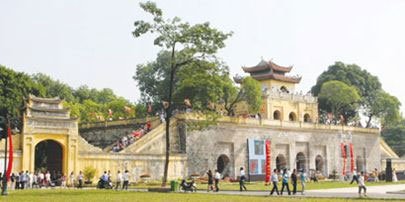
|
The park would cover 45,380sq.m, with 13,674sq.m devoted to displays of archaeological finds; 3,438sq.m to a showroom including a miniature replica of the site; 6,803sq.m for archaeological research and survey facilities; 6,214sq.m for service roads and yards; and 21,195sq.m for parks and green space.
In order to maintain architectural harmony with the existing structures and with Ba Dinh Square, new structures to be built on the site would not exceed five meters in height and would be designed to create an airy, open feeling and good views to the surrounding site.
The Hoang Dieu Archaeological Site would be linked with the National Assembly House and the Citadel by gates on Hoang Dieu, Doc Lap, Hoang Van Thu and Bac Son streets to improve visitor access. An underpass would also be built on Hoang Dieu Street, connecting the archeological site with the ancient citadel.
"The construction underground is the most effective solution," Capital Citadel Research Centre director Bui Minh Tri told Viet Nam News. "The two sites at the core of Thang Long Imperial Citadel are separated by Hoang Dieu Street, which is a very important traffic axis. We cannot prevent people from using it. But if we made a flyover, we would destroy the good views surrounding the site."
In parallel with the transformation, archaeological excavations at the site would be well-preserved, with some sites presented as underground showrooms depicting original archaeological finds and some important archaeological displays in glass cellars.
Hundreds of artefacts excavated from under the foundation of the National Assembly building in 2008-09 would be displayed in two underground storeys of the building, noted Tri, one of the project managers.
"The artefacts reflect the original architecture, art and the daily lives of the royal court through different dynasties," he said.
"However, most of the artefacts are broken, so we need time to restore them before displaying them."
Tourists would also have an opportunity to view a documentary on the excavation, he added. "The house will become a lively museum that honours and furthers the traditional values."
Tri noted that the budget for the project had not yet been determined or announced by the Prime Minister.
"We don't know yet when the restoration will start and how long it will take," he said. "We are still waiting for the Prime Minister to make a decision."
Historian Le Van Lan said project personnel consulted several models of museums, palaces and parks in different countries, including Japan's Nara Citadel, France's Gall-Roman Vesunna Museum, Italy's Roman Forum, and the Acropolis in Athens.
The Thang Long Imperial Citadel was built in the Ly Dynasty in the 11th century, marking the independence of the Dai Viet people. It was constructed on the remains of a 7th century fortress, on drained land reclaimed from the Hong (Red) River Delta. It continued as the centre of regional political power until the 19th century.
The World Heritage Committee approved a resolution in August 2010 to recognise the Thang Long Imperial Citadel as a world heritage site. The primary site includes stone dragons at Kinh Thien Palace, the Dragon House, House D67 and the famous Ha Noi Flag Tower. The site is enclosed by Phan Dinh Phung Street in the north, Dien Bien Phu Street in the south, Nguyen Tri Phuong Street in the east and Hoang Dieu Street in the west.
VietNamNet/Viet Nam News